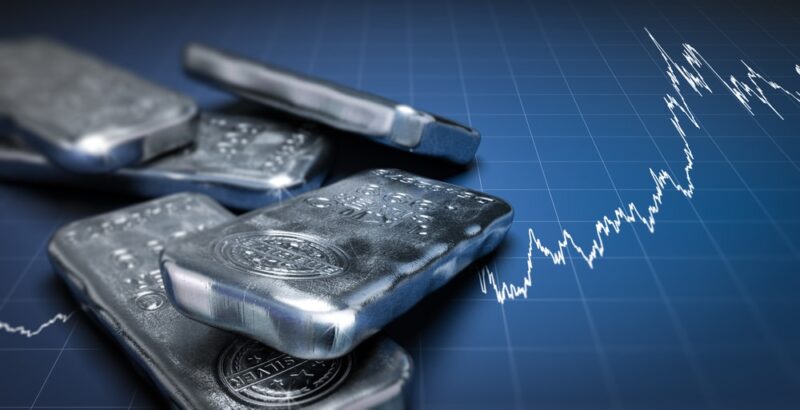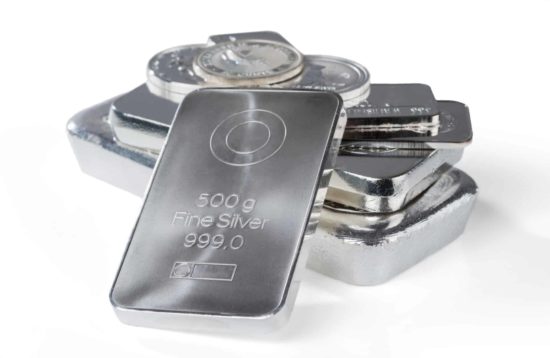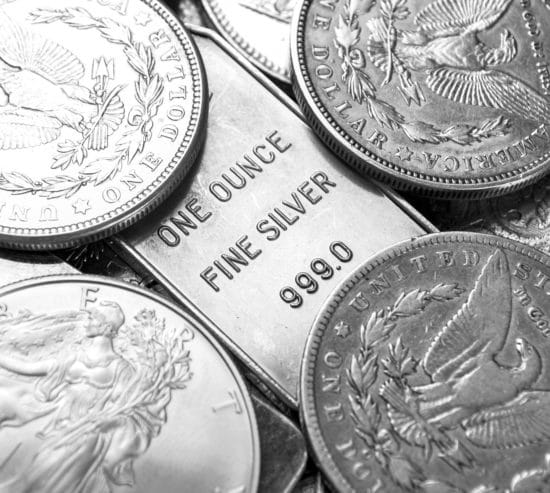How To Tell If Silver Is Real: 3 Quick Tests For Silver

By AAA
April 1, 2022
Silver is probably the precious metal you are most likely to see while out in the world. It’s an incredibly popular material that has been used for generations to make jewelry, silverware, decorative artwork, and functional items. Jewelry is commonly made from 925 Sterling Silver, while other items can be 100% pure. Just like gold and palladium, silver has a very attractive shine. This metal reflects light like a mirror when polished and cleaned correctly, and is often a prized possession.
However, there are a number of cases where you might need to know how to tell if silver is real. As a precious metal as well as a currency, counterfeit silver has been a problem for years. Additionally, as silver is such a popular choice as jewelry material, fake silver and silver-plated accessories are also common. Anyone investing in precious metals, or just looking to buy a new necklace, must know how to tell if something is real silver.
We’re going to share three quick and easy tests for silver, so you can confirm if you’re holding the genuine article. None of our methods require any special equipment or harmful chemicals; you can complete all this testing easily at home. Each one of these methods tests a specific property of pure silver. By confirming that your piece of metal has the same properties as genuine silver, you can conclude if your item is real. Read on to discover everything you need to know about testing silver at home.
Different Types of Silver
Not all products that are made from real silver use the exact same materials, as there are several different forms that silver can take. Sterling 925 Silver is one of the most popular metals to use in jewelry making. This metal is 92.5% pure silver, alloyed with a stronger metal like copper for improved durability. Sterling silver is a great choice for jewelry as it’s hardy enough to withstand regular wear. Pure silver is much softer and could become easily damaged with daily use.
Sterling silver also retains many properties of noble metals; it’s unreactive and won’t affect skin allergies or sensitivities. Pure silver, also called fine silver, can also be found in various forms. However, most .999 fine silver is in the form of silver bars, because bullion is the only efficient use of completely pure precious metals. For decorative, functional, and jewelry purposes, a stronger alloy of silver is a much better choice.

Silver can come in many forms such as bullion and coins.
How to Identify Silver
If you have a piece of silver you want to validate, you don’t need to start out with complicated tests. Often, if a silver item was made recently, or produced in a reputable jeweler, it will feature a reliable label stating it’s quality. Look for a stamp anywhere on your piece of silver featuring a number, the words fine silver, or pure silver. A numeral stating 925, 900, or 800 is an indication of the percentage of fine silver (eg. 92.5%, 80%). This is an international silver labeling system, also called a hallmark.
3 Quick Tests For Silver
We’re going to share three easy ways you can know how to tell if something is silver. There are plenty of special properties that silver and other precious metals possess, and we can validate silver by testing these characteristics. While certain silver alloys may interfere with these techniques, most fake silver won’t pass the test. You can use these three simple methods to tell real silver from counterfeit metal and ensure you’re never caught out.
Test #1: The Magnet Test
The first easy process we’re going to share with you is called the magnet test. The same testing can be used to tell if gold is real, as the yellow precious metal is also not magnetic. To perform the magnet test, you can use neodymium magnets. These will strongly attract metals such as iron, nickel, and cobalt, but no precious metal should be affected by the magnetic field. Before we explain how to do the magnet test, we’ll briefly go over the importance of magnetism in testing precious metals.
Is Silver Magnetic?
When discussing magnetism, it’s important to understand the three categories which every substance on Earth falls under. There are three classifications of materials when it comes to their susceptibility to a magnetic field; diamagnetic, paramagnetic, and ferromagnetic materials. Before we explain how to perform the magnet test, let’s explore these different categorizations.
- Diamagnetic materials have a very weak negative susceptibility to magnetic fields. This means, when exposed to a powerful magnet, diamagnetic substances will repel ever so slightly. This is because the electrons of a diamagnetic material are all paired, so cannot respond to a magnetic force. Because of this, diamagnetic materials will retain no magnetic properties after the field is removed. The majority of periodic elements on earth are diamagnetic, so they push away magnets very weakly.
- Paramagnetic materials are a weak positive susceptibility to magnetic fields, so they will attract when exposed to a strong magnet. The difference between paramagnetic and diamagnetic elements is the number of unpaired electrons; paramagnetic materials have some unpaired electrons, which can be slightly realigned in the presence of a magnet. However, paramagnetic materials also cannot retain any magnetic properties once removed from the magnetic field.
- Ferromagnetic materials also have unpaired electrons, but they’re different from paramagnetic materials. Ferromagnetic electrons have their own magnetic domain, and then exposed to a powerful external magnetic field, this magnetic domain can be permanently altered. When a ferromagnetic material is exposed to a strong magnetic force, it can become independently magnetized. Ferromagnetic materials have a strong positive susceptibility to magnetic fields.
So, how do these facts affect your silver testing techniques? Well, like every other noble metal including gold and platinum, silver is a diamagnetic material. In fact, almost every periodic element falls into this category; the majority of earth’s materials do not have a positive magnetic susceptibility. This also includes copper, the metal most commonly alloyed with silver to create the popular Sterling 925 Silver material.
We can conclude that silver is not magnetic, so testing the magnetic properties of suspicious metals is an ideal way to validate it. You can tell real silver from counterfeit metal by testing your item’s response to a magnetic field. Read on to discover exactly how to perform this technique, and how to interpret the results of your experiment.
How To Test Silver Using Magnets
You need a strong, ferromagnetic material to test silver. We recommend using neodymium magnets, a rare-earth material with a strong magnetic field. Regular fridge magnets aren’t strong enough to perform this test, so you might need to buy supplies from the hardware store. Apply the magnet to your silver item and watch for the reaction; real silver should not attract in any way towards the magnet.
There’s a more accurate magnet test you can use on silver bars, that can actually help inform you of the purity and silver content of your item. The sliding test only works on silver bars because it needs a large surface area to be possible; unfortunately, you cannot use this technique on coins or jewelry.
1. Hold your bar of silver at a 45-degree angle, with the end resting on a table or stable surface.
2. Place your magnet at the top of the silver bar, and then let it side down towards the end. Watch the speed at which your magnet travels the silver bar. It should move more slowly than you expect, descending to the end of your bar of silver in a controlled manner.
This happens because of the weak negative attraction that silver emits as a paramagnetic material. If there was no magnetic field whatsoever, the magnet would drop instantly from the metal. However, neodymium magnets can induce an electric current in silver, effectively creating an electromagnet. This acts as a brake, slowing the rare-earth magnet down as it slides over the silver. In this case, there is no attraction between silver metal and magnet. The forces actually repel against gravity, which is why your magnet should move slow.
It’s important to remember that the magnet test is not a 100% accurate way to validate silver. There are several stipulations that could affect the outcome of your test, so it’s vital to be aware of these possibilities. Firstly, there are certain non-precious metals that are silver in color and do not present any magnetic attraction. Fake silver which is also not magnetic needs to be tested using another technique in combination, so you can be assured that you own the genuine article.
Additionally, silver is a soft metal, so certain jewelry items will also include stronger materials. The clasp or fastening of a necklace, for example, could be made using a ferromagnetic material so that this weak point doesn’t break. However, this part of your piece of silver would be attracted to a magnet, so make a note of how different areas of your jewelry react. Another note to keep in mind is that silver plated items could have a ferromagnetic core. In this case, the magnetic material would experience attraction, despite the genuine silver plating.
Test #2: The Ice Cube Test
Another easy way you can tell if silver is real is by using the simple ice test. This straightforward experiment relies on another of silver’s special qualities; it’s incredible thermal conductivity. We all know that silver is the most electrically conductive metal on the planet, it’s even more effective than gold at carrying a current. However, you may not know that silver also has the highest thermal conductivity known to man. This means as well as electricity, any heat applied to a piece of silver will pass through with ease.
Just like magnetism, electrical and thermal conductivity is defined by an element’s electrons. In silver, electrons move freely, and this makes the white metal an excellent conductor of all kinds. You can use the ice cube test to measure how well your potential piece of silver conducts heat. Using the results, you should know if you own genuine silver. This test works fantastically with silver coins and bars but is more difficult to perform on jewelry.
1. You will need fresh ice directly from the freezer to complete this test. Prepare an ice cube tray and allow it to sit in your freezer for several hours before beginning the experiment.
2. Place your silver coin or bar on a flat surface. Put a fresh ice cube on top, and watch carefully for the reaction. If you own real silver, the ice will begin to melt straight away, as if you’d placed it on a hot surface. If the ice cube reacts as if sitting on a room temperature item, then unfortunately the silver isn’t genuine.
Even if your bar of silver is at regular room temperature, the ice cube will rapidly melt. This is because silver’s super-high thermal conductivity transfers heat onto the ice cube faster than any other surface can. The temperature is the same, but the rate at which it can move from your silver bar to the ice is much higher than other materials. Any ice cube sitting at room temperature will slowly melt, but put one on your silver bar to watch it quickly disappear!
Test #3: The Ring Test
The final technique we’re going to explain how to use is the ring test. This simple process is an age-old way of validating silver, and it’s one of the easiest tests you can perform at home. This method is most effective for testing silver coins, however, you may find some success with other silver products like rings. The ring test involves gently striking your silver product and listening to draw a conclusion.
Pure silver emits a pleasant bell-like ringing sound when struck on a hard surface. If you want to see this in action, test out the theory with an old United States quarter. Before 1965, quarters were made from 90% silver, and these coins are a great passing example of the ring test. When tapped against another metal, pre-65 US quarters will emit a clear, high-pitched tone. Later quarters made from less pure alloys sound dull, and not at all the same.
1. Hold the silver coin you wish to test about 6 inches above a hard surface.
2. Drop the coin, and listen to the sound when the two materials impact. A high ringing noise means genuine silver, but a dull thud means you have a fake coin.

Knowing how to test silver will keep you from getting scammed in the future.
More Comprehensive Silver Validation Techniques
When using these three techniques to test silver jewelry and other items, remember to take the results with a pinch of salt. No single home test alone can reliably validate a piece of silver, but used in combination you should be able to draw a reliable conclusion. If you need to be certain if your silver is real, a jewelry store may be able to perform more detailed testing.
If you have tested a piece of jewelry or silver using our methods and still aren’t sure if it’s real, more conclusive results can be gained with professional testing. Jewelers may use an acid test with nitric acid to validate your silver, but this is not a method we recommend using at home. Additionally, some people use a bleach test to see if silver is real, but this can damage valuable items. Bleach and acid testing for genuine silver are accurate procedures, but these three easy ways to test your silver at home are much more convenient.
How To Tell If Silver Is Real
Silver tarnishes very easily, only a tiny amount of humidity is needed to discolor and damage the metal. This means we can’t use the easiest way to spot fake gold; a visual inspection. If you see tarnish and other marks on a piece of silver, it doesn’t necessarily mean that it’s fake. Pure gold will never show any cosmetic faults, but real silver still can. If you notice tarnishing on a piece of jewelry, the item could still be pure silver. Tarnished silver coins can be easily cleaned and restored to their former glory.
Now you know three straightforward ways to test silver at home. You can use them for flatware, coins, bars, and jewelry; validate all your silver belongings with these fascinating tests! More complicated acid testing is occasionally required, but most enthusiasts can easily test their own silver at home. These clever tips and tricks make the life of a precious metals investor so much easier, as they can truly help set your mind at ease.
Buying gold and silver is a struggle as it is, so you don’t need to worry about the threat of counterfeit metal. You can set your mind at ease using these methods, and the results can also be medically important when it comes to allergies. Next time you head out to the pawnshop or coin dealers, try out one of these handy techniques.

